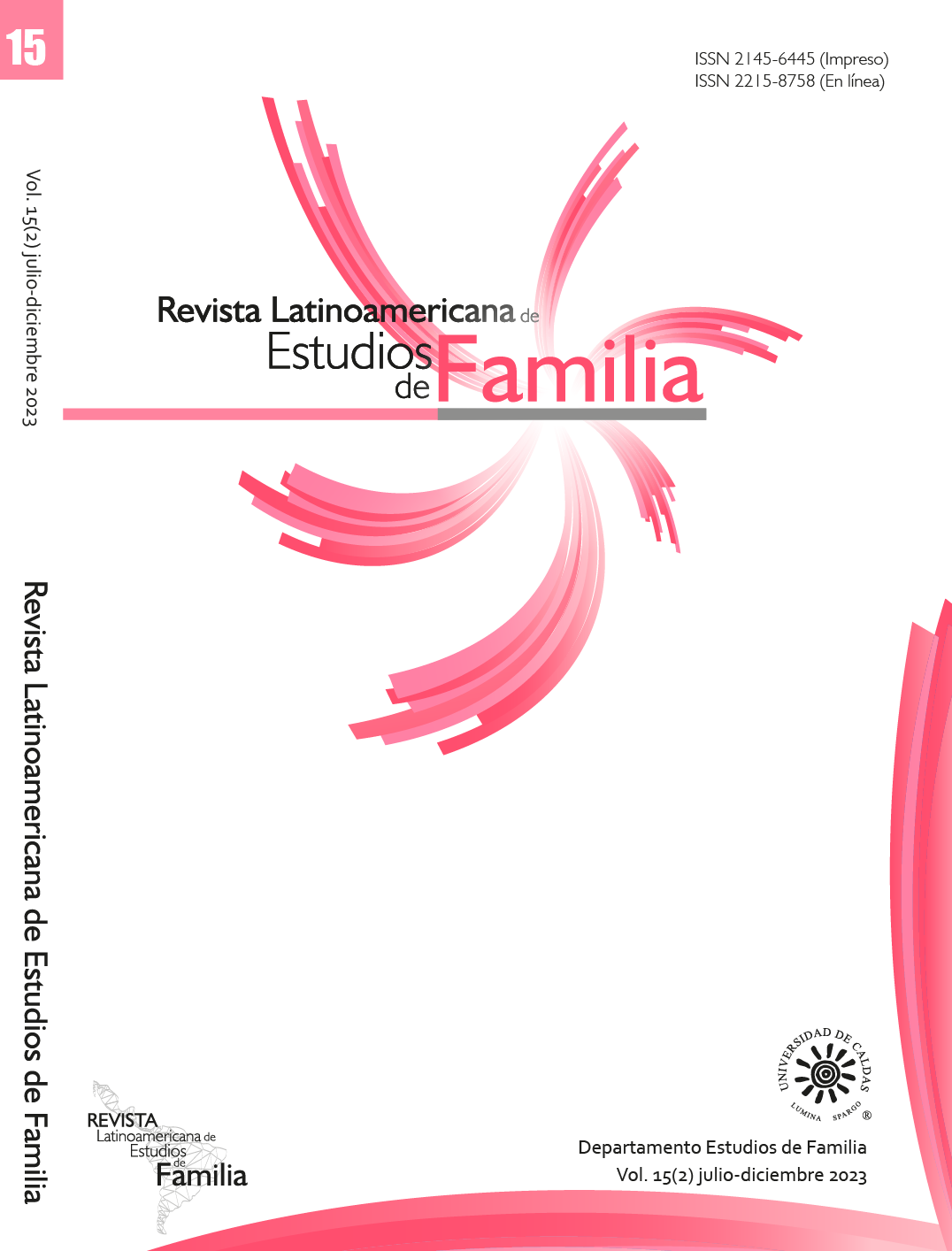Autores/as
Resumen
Este artículo aborda el impacto de la pandemia de Covid-19 en la circulación del cuidado en las familias transnacionales chinas. Con base en una etnografía multisituada entre la provincia de Zhejiang y España (2016-2019) y posterior desarrollo de una etnografía virtual (marzo 2020-marzo 2022), los resultados apuntan a las cambiantes demandas productivas, las restricciones de movilidad internacional y trabas económicas y burocráticas adicionales, así como a las percepciones de seguridad en los diferentes contextos nacionales, como factores clave en la reconfiguración de la (in)movilidad física relacionada con el cuidado. En paralelo, se da una creciente movilidad virtual e hiperconexión que revela el rol clave de las tecnologías de la información y la comunicación (TIC) en este contexto. Las conclusiones enfatizan la alteración de algunos patrones de circulación de cuidado habituales y la necesidad de abordar una investigación longitudinal para conocer el alcance real de los efectos de la pandemia.
Palabras clave
Citas
Baldassar, L. y Merla, L. (Eds.). (2014). Transnational Families, Migration and the Circulation of Care:Understanding Mobility and Absence in Family Life. Routledge.
Baldassar, L., Nedelcu, M., Merla, L. y Wilding, R. (2016). ICT-based co-presence in transnational families and communities: challenging the premise of face-to-face proximity in sustaining relationships. Global Networks, 16, 133-144. https://doi.org/10.1111/glob.12108
Bell, J., Staver, A. B. y Tolgensbakk, I. (2023). State crisis response versus transnational family living:An online ethnography among transnational families during the pandemic. Migration Studies, 14. https://doi.org/10.1093/migration/mnad014
Beltrán, J. (2003). Los ocho inmortales cruzan el mar. Chinos en Extremo Occidente. Edicions Bellaterra.
Beltrán, J. y Sáiz, A. (2013). Del restaurante chino al bar autóctono. Evolución del empresariado de origen chino en España y su compleja relación con la etnicidad. En M. Barros y H. Valenzuela (Eds.), Retos y estrategias del empresariado étnico contemporáneo. Estudios de caso de empresarios latinos en Estados Unidos y empresarios étnicos en España (pp. 85-108). CIESAS.
Beltrán, J. y Sáiz, A. (2023). Impacto de la pandemia COVID-19 en la población de origen chino en España. Compàs d’amalgama, 7, 33-37.
Bohr, Y. y Tse, C. (2009). Satellite Babies in Transnational Families: A study of Parents’ Decision to Separate from their Infants. Infant Mental Health Journal, 30, 265-286. DOI: 10.1002/imhj.20214
Brandhorst, R., Baldassar, L. y Wilding, R. (2020). Introduction to the Special Issue:Transnational Family Care ‘On Hold’? Intergenerational Relationships and Obligations in the Context of Immobility Regimes. Journal of Intergenerational Relationships, 18(3), 261-280. DOI: 10.1080/15350770.2020.1787035
Braun, V. y Clarke, V. (2012). Thematic analysis. En H. Cooper (Ed.), APA handbook of research methods in psychology: Vol. 2. Research designs (pp. 57-91). American Psychological Association.
Bryceson, D. F. y Vuorela, U. (2002). Transnational Families in the 21st Century. En D. F. Bryceson y U. Vuorela (Eds.), The transnational family: New European Frontiers and Global Networks (pp.3-30). Berg Publishers.
Cabezón-Fernández, M.-J. y Oso, L. (2022). La (in)movilidad a debate: Diez años de estudio de las migraciones en la España entre crisis (2009-2021). Migraciones. Revista del Instituto Universitario de Estudios sobre Migraciones, 55, 1-22. https://doi.org/10.14422/mig.2022.005
Carling, J. y Erdal, M. B. (2014). Return Migration and Transnationalism: How Are the Two Connected? International Migration, 52(6), 2-12.
https://doi.org/10.1111/imig.12180
Ceccagno, A. (2003). New Chinese Migrants in Italy. International Migration, 41, 187-213. https://doi.org/10.1111/1468-2435.00246
Da, W. W. (2003). Transnational Grandparenting: Child Care Arrangements among Migrants from the People’s Republic of China to Australia. Journal of International Migration and Integration, 4(6), 79-103. https://doi.org/10.1007/s12134-003-1020-4
Faist, T. (1998). Transnational social spaces out of international migration: Evolution, significance and future prospects. European Journal of Sociology, 39(2), 213-247.
Fisher, B. y Tronto, J. (1990). Toward a Feminist Theory of Caring. En E. K. Abel y M. K. Nelson (Eds.),Circles of Care (pp. 35-62). State University of New York Press.
Gao, G. y Sai, L. (2021). Opposing the toxic apartheid: The painted veil of the COVID-19 pandemic,race and racism. Gender Work Organ, 28(S1), 631-637. https://doi.org/10.1111/gwao.12523
Glenn, E. N. (2000). Creating a Caring Society. Contemporary Sociology, 29(1), 84-94. https://doi.org/10.2307/2654934
Glick, N. y Salazar, N. B. (2013). Regimes of Mobility Across the Globe. Journal of Ethnic and Migration Studies, 39(2), 183-200. DOI: 10.1080/1369183X.2013.723253
Glick, N., Szanton-Blanc, C. y Basch, L. G. (1992). Towards a Transnational Perspective on Migration:Race, Class, Ethnicity, and Nationalism Reconsidered. Academy of Science Editors.
Guo, L. (2017). WeChat as a Semipublic Alternative Sphere: Exploring the Use of WeChat Among Chinese Older Adults. International Journal of Communication, 11, 408-428. https://ijoc.org/index.php/ijoc/article/view/5537
Hoang, L. A. y Yeoh, B. S. A. (2012). Sustaining Families across Transnational Spaces: Vietnamese Migrant Parents and their Left-Behind Children. Asian Studies Review, 36(3), 307-325. https://doi.org/10.1080/10357823.2012.711810
Hochschild, A. R. (2000). Global Care Chains and Emotional Surplus Value. En W. Hutton y A.Giddens (Eds.), On the Edge: Living with Global Capitalism (pp. 130-146). Jonathan Cape.
Hu, Y., Xu, C. L. y Tu, M. (2022). Family-mediated migration infrastructure: Chinese international students and parents navigating (im)mobilities during the COVID-19 pandemic. Chinese Sociological Review, 54(1), 62-87, DOI: 10.1080/21620555.2020.1838271
INE (Instituto Nacional de Estadística). (2023). Principales series de población desde 1998. Población extranjera por Nacionalidad, comunidades, Sexo y Año. Total nacional. https://www.ine.es/jaxi/Tabla.htm?path=/t20/e245/p08/l0/&file=02005.px&L=0
Kempny, M. (2023). COVID-19, (im)mobilities and blockages: Re-thinking mobilities of migrant women in Northern Ireland. Global Networks, 23, 75-89. DOI: 10.1111/glob.12395
Kilkey, M. y Merla, L. (2014). Situating Transnational Families’ Care-giving Arrangements: The Role of Institutional Contexts. Global Networks, 14(2), 210-229. https://doi.org/10.1111/glob.12034
King-O’Riain, R. C. (2015), Emotional streaming and transconnectivity: Skype and emotion practices in transnational families in Ireland. Global Networks, 15, 256-273. https://doi.org/10.1111/glob.12072
Lamas Abraira, L. (2022). A state-of-the-art review and future directions in gender and migration research. En N. Ribas-Mateos & S. Sassen (Eds), A Research Agenda for Gender and Global Migration beyond Western Research (pp.24-37). Edward Elgar Publishing
Lamas-Abraira, L. (2021). Chinese Transnational Families: Care Circulation and Children’s Life Paths. Routledge.
Lamas-Abraira. L (2019) Care circulation and the so-called ‘elderly’: exploring care in 4G transnational Zhejianese families. Journal of Family Studies, 27(3), 460-478, DOI: 10.1080/13229400.2019.1641 427Lan, P. C. (2002). Subcontracting Filial Piety: Elder Care in Ethnic Chinese Immigrant Families in California. Journal of Family Issues, 23(7), 812-835. https://doi.org/10.1177/019251302236596
Levitt, P. (2001). The Transnational Villagers. University of California Press.
Lie, M. L. S. (2010). Across the Oceans: Childcare and Grandparenting in UK Chinese and Bangladeshi Households. Journal of Ethnic and Migration Studies, 36(9), 1425-1443.DOI: 10.1080/1369183X.2010.491746
Madianou, M. (2016). Ambient Co-presence: Transnational Family Practices in Polymedia Environments. Global Networks, 16(2), 183-201.
https://doi.org/10.1111/glob.12105
Madianou, M. y Miller, D. (2012). Migration and New Media: Transnational Families and Polymedia. Routledge.
Masdeu, I. (2014). Mobilities and Embodied Transnational Practices: An Ethnography of Return(s) and other Intersections between China and Spain (tesis doctoral). Universitat Autònoma de Barcelona, España.
Mata-Codesal, D. (2015). Ways of Staying Put in Ecuador: Social and Embodied Experiences of Mobility–Immobility Interactions. Journal of Ethnic and Migration Studies, 41(14), 2274-2290. DOI: 10.1080/1369183X.2015.1053850
Menjívar, C. (2006). Family Reorganization in a Context of Legal Uncertainty: Guatemalan and Salvadoran Immigrants in the United States. International Journal of Sociology of the Family, 32(2),223-245. http://www.jstor.org/stable/23030196
Merla, L. y Baldassar, L. (2016). Concluding Reflections: ‘Care Circulation’ in an Increasingly Mobile World: Further thoughts. Papers, 101(2), 275-284. DOI: 10.5565/rev/papers.2268
Merla, L., Kilkey, M. y Baldassar, L. (2020). Examining transnational care circulation trajectories within immobilizing regimes of migration: Implications for proximate care. Journal of Family Research,32(3), 514-536. https://doi.org/10.20377/jfr-351
Michel, S. y Peng, I. (Eds.). (2017). Gender, Migration, and the Work of Care. Palgrave Macmillan.
MISSM (Ministerio de Inclusión, Seguridad Social y Migraciones). (2023). Estadísticas Seguridad social. Afiliados medios extranjeros por nacionalidad y régimen. Años 2021 y 2022. https://lc.cx/ZCvpFk
MISSM (Ministerio de Inclusión, Seguridad Social y Migraciones). (2021). Estadísticas Seguridad social. 2009-2020 Afiliados medios extranjeros por nacionalidad y régimen. https://lc.cx/YR-Clv
Nedelcu, M. y Wyss, M. (2016). Doing Family’ through ICT-mediated Ordinary Copresence:Transnational Communication Practices of Romanian Migrants in Switzerland. Global Networks,16(2), 202-218. https://doi.org/10.1111/glob.12110
Neysmith, S. M. y Zhou, Y. R. (2013). Mapping Another Dimension on a Feminist Ethics of Care: Family-based Transnational Care. The International Journal of Feminist Approaches to Bioethics, 6(2), 141-159. https://doi.org/10.3138/ijfab.6.2.141
OPI (Observatorio Permanente de la Inmigración). (2022). Estadística de extranjeros residentes en España.Principales nacionalidades del total de extranjeros residentes en España a 20/06/2022.
https://extranjeros.inclusion.gob.es/ficheros/estadisticas/operaciones/con-certificado/202206/Notaanalisis.pdf
OPI (Observatorio Permanente de la Inmigración). (2023). Extranjeros con autorización de residencia según sexo, nacionalidad y motivo de concesión. https://lc.cx/W7DCX9
Pérez, A. (2014). Subversión feminista de la economía: aportes para un debate sobre el conflicto capitalvida. Traficantes de Sueños.
Rajan, S. R. y Neetha, N. (Eds.). (2019). Migration, Gender and Care Economy. Routledge.
Ruiz, M. R. y Aguirre, G. (2015). Etnografía virtual, un acercamiento al método y a sus aplicaciones.Estudios sobre las Culturas Contemporáneas, 11(41), 67-96.
Sáiz, A. (2005). La migración china en España. Características generales. Revista CIDOB d’Afers Internacionals, 68, 151-163.
Sáiz, A. (2012). Transnationalism, Motherhood, and Entrepreneurship: Chinese Women in Spain. En M. Texler, E. N. L. Chow y V. Demos (Eds.), Social Production and Reproduction at the Interface of Public and Private Spheres (pp. 39-59). Emerald Group Publishing Limited.
Salazar, N. B. (2021). Immobility: The relational and experiential qualities of an ambiguous concept.Transfers, 11(3), 3-21.
Sampaio, D. (2020). Caring by Silence: How (Un)documented Brazilian Migrants Enact Silence as a Care Practice for Aging Parents. Journal of Intergenerational Relationships, 18(3), 281-300. DOI: 10.1080/15350770.2020.1787038
Simola, A., May, V., Olakivi, A. y Wrede, S. (2023). On not ‘being there’: Making sense of the potent urge for physical proximity in transnational families at the outbreak of the COVID-19 pandemic.Global Networks, 23, 45-58. https://doi.org/10.1111/glob.12382
Skovgaard-Smith, I. (2023). Transnational life and cross-border immobility in pandemic times. Global Networks, 23, 59-74. https://doi.org/10.1111/glob.12350
Sun, C. Y. (2017). Negotiating Transnational Ambivalence: How Ageing Parents Grapple with Family Separation across Time. Identities, 24(5), 590-605. https:// doi.org/10.1080/107029X.2017.1345542
Wang, S., Chen, X., Li, Y., Luu, C., Yan, R. y Madrisotti, F. (2010). ‘I’m more afraid of racism than of the virus!’: racism awareness and resistance among Chinese migrants and their descendants in France during the Covid-19 pandemic. European Societies, 23(1), 721-742.
DOI: 10.1080/14616696.2020.1836384
Wong, K. R. (2015). The Fengsu-Driven Practice of Sending Infants to China: The Experiences of Chinese Immigrant Mothers in New York (tesis doctoral). CUNY Academic Works.
Xie, X. y Xia, Y. (2011). Grandparenting in Chinese Immigrant Families. Marriage & Family Review, 47(6), 383-396.
DOI: 10.1080/01494929.2011.594218

 PDF
PDF
 FLIP
FLIP

























